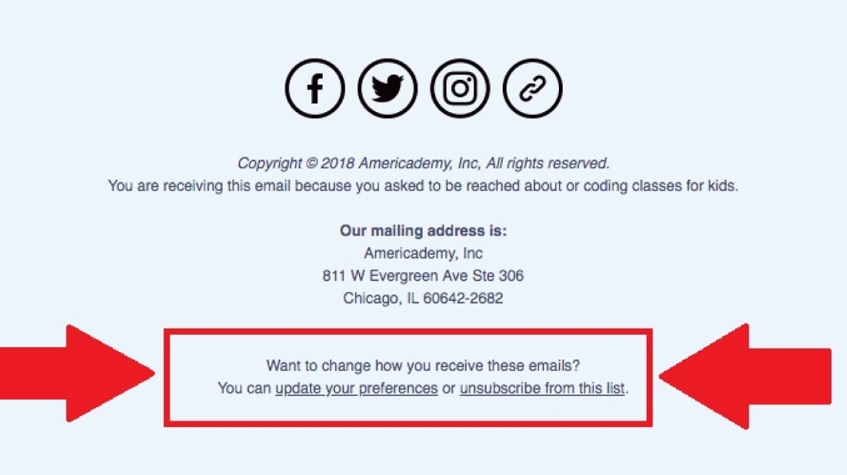Although the unsubscribe rate is a crucial key performance indicator (KPI) that should be closely watched, most marketing teams would prefer not pay too much attention to it. Focusing on obtaining new subscribers seems far more enticing, but having an unsubscribe option and understanding your unsubscribe rate is crucial.
Before diving into the critical elements of understanding your unsubscribe rate and how to calculate it, many marketers want to know whether it is necessary to include an unsubscribe link in email campaigns. The objective of your campaigns is not to lose subscribers, so why should you make it simple for them to unsubscribe? Exist regulations mandating that marketers provide a link in their email marketing for the express purpose of unsubscribing?
What are the legal requirements for unsubscribe links?
Although we cannot offer legal counsel, we may supply you with further information on the laws governing digital and email marketing.
Digital life does not occur inside a single country’s boundaries, thus there may be several laws or views to consider when determining whether or not an unsubscribe link is required by law. Such a statute is the United States’ CAN-SPAM Act. This regulation, which is administered by the Federal Trade Commission, stipulates that you must provide a method for subscribers to opt out of receiving promotional communications.
Specify how recipients may opt out of getting email from you in the future. Your email must provide a clear and prominent description of how the receiver may opt out of receiving future emails from you. Create a notification that is simple for the average person to identify, read, and comprehend. The inventive use of text size, color, and placement may enhance readability. Provide a return email address or another simple Internet-based method for individuals to indicate their preference to you. You may construct a menu that allows recipients to opt out of receiving particular sorts of communications, but you must also give an option to opt out of receiving all of your commercial messages. Ensure that your spam filter is not blocking these unsubscribe attempts.
Likewise, the Canadian Anti-Spam Legislation (CASL) requires a sender of commercial electronic communications to “specify an electronic address or link to a website on the World Wide Web that may be viewed by a web browser” Even while this is not the whole of CASL’s standards for offering the possibility to unsubscribe, it demonstrates a widespread belief that the unsubscribe method should be included into your contact with your subscribers and not buried. Article 7 of the General Data Protection Regulation (GDPR) addresses consent explicitly for the first time, stating a person’s ability to withdraw permission:
It must be as simple to withdraw permission as it is to provide it.
Though they take varied methods, all laws ultimately strive to ensure that consent is given and withdrawn fairly by persons.
Should I include an opt-out link in my email campaign?
Numerous international regulations, including those stated above, unambiguously support the ability of subscribers to withdraw permission and emphasize that senders must play an active part in ensuring this right.
Numerous businesses include an unsubscribe link at the bottom of their emails or give a link to a preference center where users may modify their subscription preferences. The majority of email service providers provide these connecting possibilities in their email builder.
This illustration from Codeverse provides its readers with alternatives in an exemplary manner. They include not just an unsubscribe link, but also a link to modify their email subscription settings, so that users do not have to opt out of receiving emails entirely.

Source: Really Good Emails
This sample from Codeverse provides its readers with alternatives in an exemplary manner. They include not just an unsubscribe link, but also a link to modify their email subscription settings, so that users do not have to opt out of receiving emails entirely.
How to calculate your rate of Unsubscription
Knowing your unsubscribe rate is just half the fight, and although modern marketing tools automate much of the process, it’s always a good idea to be able to perform the arithmetic yourself. Calculating your email campaign’s unsubscribe rate is quite straightforward. Start with the total number of unsubscribes received by a campaign, then divide that number by the total number of emails sent. Multiply the amount by 100 to get the actual percentage.
Unsubscribe rate = (Total Number of Unsubscribes / Total Number of delivered emails) x 100
Is it important to know your unsubscribe rate?
Knowing your unsubscribe rate may reveal a great deal about the efficacy of your email marketing activities. It allows you to monitor your email frequency (are you emailing subscribers too frequently?). and whether or not the content of your email is relevant (is this campaign attractive to your subscribers?). If you see that a certain email campaign is generating a larger number of unsubscribes than normal, analyze the content to determine how you might enhance your other efforts.
What Next?
Now that you have a basic grasp of unsubscribe rates and the regulations governing unsubscribe links, you should examine what an acceptable unsubscribe rate is for email marketing so that you may optimize your campaigns for better outcomes. We will be publishing an article in regards to ideal un-subscribe rates and what to do if you have very high un-subscribe rates.



